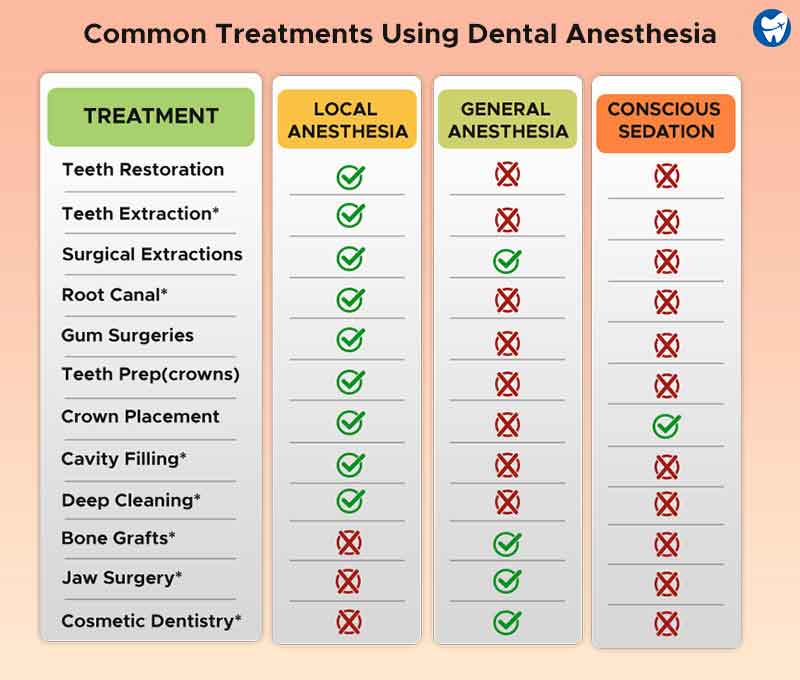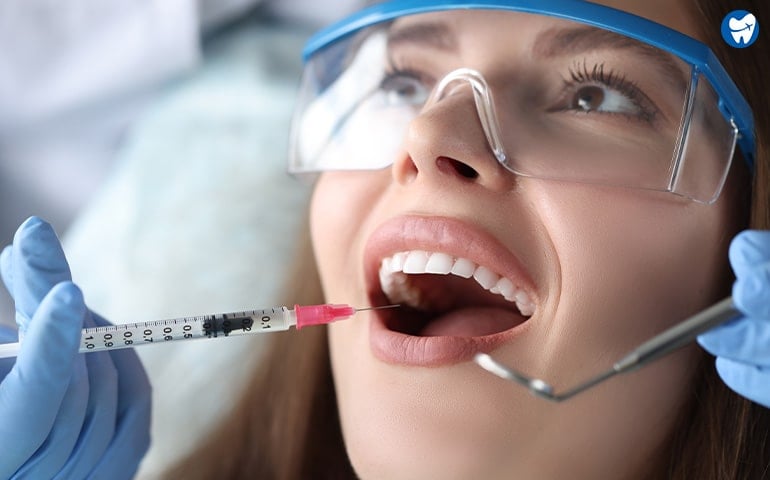Most dental treatments will use some type of dental anesthesia. Understanding anesthesia types, side effects of anesthesia, and how long anesthesia lasts can help you choose the best option for your situation.
Common Treatments Using Dental Anesthesia
*Source: NewMouth.com [1]
What is Dental Anesthesia? What are the Types Available?
There are plenty of options to make your dental operations more relaxing and comfortable.
Factors like the type of treatment, your anxiety levels, allergies, and overall health can play a part in deciding the type of sedation. [2]
Video Courtesy: Bethea Medical Media
There are three types of dental anesthesia – local, general, and conscious sedation.
Read on to find out their cost, what to expect with each, and side effects.
Local Anesthesia
Local anesthetic is one of the most common types of dental anesthesia. It’s “local” because it only numbs the immediate area where it’s applied.
This type of anesthesia is used for dental fillings, crowns, or anything that requires numbing of a tooth.
Local Anesthesia | Dental Anesthesia Type
How Does It Work?
These are injected into the nerve supply feeding the tooth that needs to be numbed.
The medications block the nerve sensations, preventing pain receptors from sending signals to your brain. [3]
Pressure is typically the only thing you’ll be able to feel.
When Is It Required in Dental work?
Your dentist uses a local anesthetic for dental fillings or any procedure when your tooth.
- Feels irritation during treatment
- Needs drilling or altering its structure
Even if you’re getting sedation or general anesthesia, your dentist will still use a local anesthetic for the tooth that’s being treated.
Duration and Intensity
This type completely numbs the treatment area. Depending on the nerves in that space, you may need 2-3 injections.
Once you receive the desired dose, you shouldn’t feel anything other than pressure. The area to be worked on will be numb.
Wondering how long local anesthesia lasts? Typically one to two hours, however, it can last longer depending on the person or dose given.
More complicated procedures require a higher dose or a stronger, longer-lasting formulation.
It takes effect quickly within 10 minutes, but the numbing sensation will gradually decrease over time.
Cost
The cost is typically rolled into the fee for other treatments, such as fillings or crowns. It usually is not billed separately.
But if it is, it’s fairly inexpensive and can easily be paid for out of pocket.
General Anesthesia
General anesthesia makes you unconscious. It affects your whole body, relaxing your muscles and inducing amnesia.
You will feel minimal to no pain and not remember the procedure.
General Anesthesia | Dental Anesthesia Type
How Does It Work?
General anesthesia is administered by a trained professional such as an anesthesiologist or an oral-maxillofacial surgeon. [4]
The medication flows through an IV or face mask. The dosage depends on the procedure and the individual patient.
The effects are fast-acting. You will fall asleep and won’t remember the treatment when you wake up. [5]
When Is It Required in Dental work?
In modern dentistry, general anesthesia is used for: [6]
- Dental implant placement
- Wisdom tooth removal
- Other more extensive oral treatments
As sedation needs vary for different people, your dentist can determine the best option for you.
Duration and Intensity
This type provides the deepest level of “sedation” in dental practices.
If you’re one of those who say you want to “sleep through the procedure” or be “completely knocked out,” this is the level of anesthesia that you wish to request.
The intensity of general anesthesia allows your dentist or specialist to work efficiently to combine multiple steps of care within one appointment.
As such, you can schedule fewer visits.
Once your procedure is complete, the anesthetic drip is turned off, and you will gradually regain consciousness.
A few hours of drowsiness afterward are common.
Cost
The price of general anesthesia is higher than other types because of the specialized level of care.
For instance, you may need to have an additional health care provider present to administer the medication, or your dentist may need to complete the treatment at an offsite medical facility.
Choosing a dentist with an on-site anesthesia provider and in-house surgical facilities can reduce the out-of-pocket costs related to general anesthesia.
Concious Sedation
Sedation dentistry involves a variety of options. While sedation is sometimes used interchangeably with anesthesia, the two are not the same thing. [7]
Sedation Dentistry | Dental Anesthesia Type
Most dental sedation will consist of [8]
- Nitrous oxide gas (also called happy gas or laughing gas) or,
- Oral conscious sedation
- I.V. Sedation
How Does It Work?
You inhale nitrous oxide mixed with oxygen through a small mask over your nose. The gas helps you feel calm and relaxed. [9]
You’ll be fully aware of everything going on, but you won’t care as much as you usually would.
With oral medication sedation, you take prescription medication before your treatment that causes you to feel very sleepy, yet not unconscious. [10]
When Is It Required in Dental work?
Inhalation sedatives like nitrous oxide can be used any time a person feels a little anxious or wants to relax a bit more. It’s commonly during
- Teeth cleanings
- Dental fillings
- Root canals
- Dental implants
Oral sedation is a bit different. It is used for patients who have mild to moderate anxiety or who require:
- Multiple treatments in one sitting
- Longer/lengthier procedures
- Complex treatments
Duration and Intensity
Laughing gas/nitrous oxide wears off within a few minutes of turning it off. You can even drive yourself home afterward.
However, oral medication sedation will take a few hours to wear off; you will need someone to accompany you to your appointment.
Nitrous oxide can usually be added to an appointment by request.
However, oral sedation requires some planning as medications are prescribed, and you will need a companion to help get you home. [11]
Cost
The cost of nitrous oxide sedation is fairly inexpensive. Typically, it’s a low-cost add-on to your planned dental appointment.
Oral sedation costs a bit more than laughing gas but is more affordable than IV anesthesia.
How Much Does Sedation Dentistry Cost?
On average, the dental anesthesia cost varies from $100 to $1,000.
The price depends on the type of anesthesia and the length of your dental procedure.
Below are the prices of various types of dental anesthesia in the USA.
Dental Anesthesia Cost in the US (USD)
| Type of Anesthesia | Cost |
| General Anesthesia | $1,000 |
| IV dental sedation (Sleep dentistry) | $900 |
| Inhalation sedation (Nitrous oxide) | $100 |
| Light oral sedation | $500 |
| Local anesthesia* | No fee for numbing the sites |
*According to ADA, local anesthesia carries no additional charges. It is considered a part of most dental treatments.
Don't have insurance coverage? We have you covered!
Save ~80% abroad!Side Effects of Dental Anesthesia
| Anesthesia Type | Side Effects |
| Local | Temporarily lose the ability to blink |
| Blood-filled swelling | |
| Increased heartbeat | |
| Potential nerve damage | |
| Sedation |
Headache, nausea, drowsiness |
| Pain at the site | |
| Difficulty urinating | |
| Blood-filled swelling | |
| Nerve damage | |
| General |
Nausea and vomiting |
| A sore throat | |
| Muscle aches, itches | |
| Elevated body temperature |
Source: Colgate
Special Precautions
Various types of dental anesthesia require different precautions. For instance:
- You may avoid nitrous oxide sedation if you are allergic to eggs.
- If you’re sensitive to epinephrine or have heart problems, a non-epinephrine local anesthetic is preferred. [13]
Communicating with your dentist about your needs and expectations will ensure you receive the type of care you’re looking for.
It can also minimize costs or unwanted side effects.
Be sure to share your medical history, including recent hospitalizations, medications you’re taking, etc.
Although many people assume that general health won’t affect their teeth, the two are closely related.
Communication can limit your risk of dental anesthesia side effects.
Local Anesthesia vs. General Anesthesia vs. Sedation
| Point of difference | Local Anesthesia | General Anesthesia | Concious Sedation |
| Complete loss of consciousness | X |  |
X |
| Verbal contact |  |
X |  |
| Complete control of the airway | X |  |
X |
| Impact cardiovascular function | X |  |
X |
| Fasting before surgery | X |  |
 |
| Require hospital setting | X |  |
 |
| Downtime* | X |  |
 ** ** |
| Quick recovery |  |
X |  |
| Separate billing | X |  |
 |
Source: News-Medical.Net
*Downtime – Resting period; **No downtime for inhalation sedation
Dental Anesthesia Wrap-up
Most people receiving dental anesthesia during their dental appointment will be getting local anesthetic and possibly laughing gas.
But if you want the deepest level of relaxation, you’ll be getting general anesthesia or sedation with local anesthesia.
When looking for pain-free dental treatments, choosing an anesthetist or a licensed dentist to administer dental anesthesia is essential.
DentaVacation can connect you with hand-picked dental clinics overseas.
FAQs
Most anesthesia lasts for a few hours before wearing off. The exact time can vary from one person to the next.
It will last longer than your planned dental procedure, ensuring your comfort throughout the entire appointment.
Local anesthetic typically keeps your mouth numb longer than the planned appointment.
Depending on the individual, numbing shots tend to wear off completely within 3-5 hours.
Your dentist applies numbing gel before any oral injections. Since your mucosa is so sensitive, we will first apply a numbing gel so that you won’t feel the pain.
However, you might have a slight burning sensation after the procedure.
The feeling of numbed mouth is often described as full, asleep, or tingling.
Sometimes, you may feel numbness in your chin, cheeks, tongue, nose, and below your eyes, depending on the treatment area.
If your tooth hurts, your dentist will need to administer more anesthetics. Most people say that dental anesthesia makes their mouth feel “fat.”
Absolutely. Dental anesthesia is a safe and effective method to reduce anxiety with valium 10mg and eliminate pain during dental treatments. [14]
Moreover, working with a licensed dentist or anesthetist ensures that your safety is a top priority throughout your appointment.
Anesthetic is injected into the tissues, however, if some of the solution is expelled in the mouth there is no harm in swallowing it.
Most local anesthetic is covered by insurance or included in the cost of your dental procedure.
Nitrous oxide (laughing gas) may or may not be covered but is relatively inexpensive.
Other options like conscious sedation or general anesthesia may require a co-pay or be included in your medical insurance benefits.
Talk to your dentist beforehand for a cost estimate.






